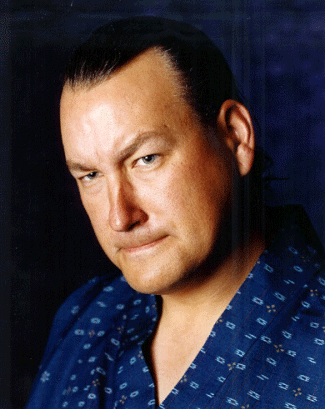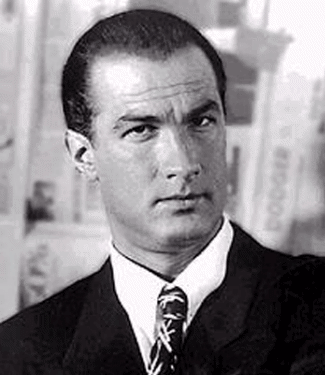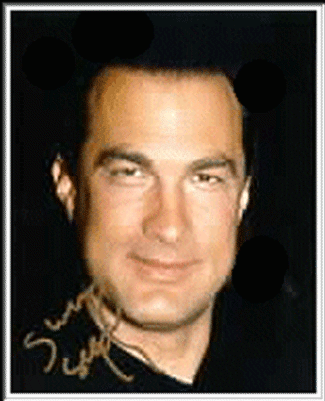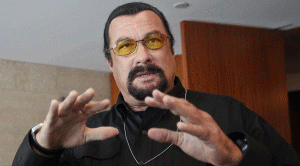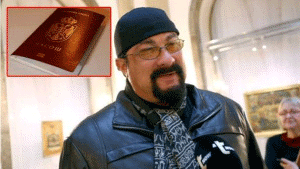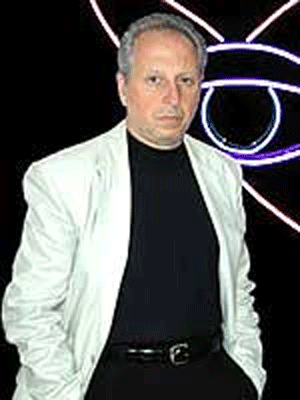SEAGAL UNDER SIEGEby Ned Zeman
Vanity Fair
October 2002
(Additional reporting for this article was done by John Connolly)
NOTICE: THIS WORK MAY BE PROTECTED BY COPYRIGHTYOU ARE REQUIRED TO READ
THE COPYRIGHT NOTICE AT THIS LINK BEFORE YOU READ THE FOLLOWING WORK, THAT IS AVAILABLE SOLELY FOR PRIVATE STUDY, SCHOLARSHIP OR RESEARCH PURSUANT TO 17 U.S.C. SECTION 107 AND 108. IN THE EVENT THAT THE LIBRARY DETERMINES THAT UNLAWFUL COPYING OF THIS WORK HAS OCCURRED, THE LIBRARY HAS THE RIGHT TO BLOCK THE I.P. ADDRESS AT WHICH THE UNLAWFUL COPYING APPEARED TO HAVE OCCURRED. THANK YOU FOR RESPECTING THE RIGHTS OF COPYRIGHT OWNERS.
It's tough separating myth from reality in Steven Seagal's world of CIA black ops, concealed Colt .45s, and a reincarnated Tibetan master. But prosecutors say Seagal got genuine death threats, courtesy of his former producer Jules Nasso, and the fading action star appears to have tangled with a top crime family.
Somewhere between the large marble panther in his foyer and the large marble lion on his front staircase, the biggest player on Staten Island pauses for quiet reflection. Lately, and pretty much ever since Jules Nasso got jammed up, he's been in a pensive mood. Fortunately, his house is all about reflectiveness. The place is 8,500 square feet of pure Zen, featuring a lagoon-style pool and a purple-and-green master bedroom with fireplace, sauna, and a spiral staircase that leads to a kind of library-in-the-sky--not to mention the ocean view, which is, as they say locally, "primo." Villa Terranova, Nasso calls the house. That's Italian for "new world."
Nasso grew up in and around the Bensonhurst section of Brooklyn, that famously Italian enclave, and the old neighborhood still informs much of what he does. And yet...and yet. Today, at 49, he's a long way from the streets of Bensonhurst, having parlayed a scrappy little pharmaceutical business into a big, honking career in motion pictures. With two Mercedeses in the gated driveway, there is success written all over his well-groomed diminutive personage. "The biggest people in Hollywood have been here," Nasso says. He's got the studio-mogul look down--a white-and-yellow terry-cloth beachwear ensemble, off-yellow slippers, a gold bracelet, a silver-and-gold wristwatch, a lovely assistant serving him sliced melon, then oatmeal, then noci cioccolati on gold-embossed china.
"Chi," Nasso says, stroking his marble panther. He drifts past the screening room, the 20-odd model ships (including a five-and-a-half-foot-long Lusitania), and the giant peacock mural. The walls are painted with florid images that Nasso describes as "illusional." By which he means: "Look at them one way and they're just shapes. Look closer and they've got meaning." Indeed, closer inspection reveals that one of the images is that of a large thumb, and not just any thumb, either, "Danny Aiello's thumb," Nasso elucidates, nodding. Aiello, the gifted and voluble character actor, and one of Nasso's closest friends, took a shine to the murals one night. Next thing he knew, his thumb portrait's on the wall, not far from a mural composed of female body parts, rendered by Nasso's omnipresent decorator, Jimmy DaLuise, a tattooed, thickly muscled gentleman with the body of a linebacker and the hands of an angel. "See?" says Jimmy, pointing to a particular section of the mural. "It's an ass."
It's not what is is," Nasso explains, speaking about the house in general. "It's what it gives off. It's Zen. It's chi. Like Mike Ovitz does it. It's Ovitzean."
Nasso traces both his chi and his "celebrityness" back to Hollywood's fallen Zen master. "Real gentleman, Ovitz," Nasso says. "Knows his Zen. Stand-up guy." After all, Ovitz discovered and groomed Nasso's former meal ticket, the swaggering action star Steven Seagal, whose partnership with Nasso spanned some 15 years, from 1986 until last year, and 10 films, including the hits On Deadly Ground (1994) and Under Siege 2 (1995). For years, Seagal even co-owned a large guesthouse adjacent to Villa Terranova. The two men's friendship wasn't simply about money and stardom. They shared an interest in Zen. And chi. And the Tao, as well as the Dow--i.e., they both made money.
But what of their friendship today? Where'd all the Zen go? Seagal's film career is in a death spiral, thanks in part to his vile, simian behavior toward colleagues, women, employees, and reporters--not to mention his serial dissembling, his dime-store theology, and his all-around vulgarism. That he is Hollywood's longest-running bad joke is no news flash. But the headlines that broke in June were:
MOB SAID TO HAVE THREATENED ACTOR. Courts: Steven Seagal is widely believed to be the murder target in extortion case.
As part of a 68-count extortion-and-racketeering case against 17 purported members of the Gambino crime family and associates, federal prosecutors had obtained wiretapped conversations in which Peter Gotti's fearsome number two, Anthony "Sonny" Ciccone, allegedly said that if Seagal didn't pony up millions of dollars the Gambinos were "gonna hurt him." On at least two occasions, Seagal was threatened until "petrified," Ciccone allegedly bragged. Then the kicker: on the other end of certain of the taped conversations was ...Jules Nasso, who prosecutors say was a key player behind the extortion scheme.
It got curiouser and curiouser. In June while reporting on the dispute, Los Angeles Times reporter Anita Busch found a hole smashed in her car windshield, evidently by a hammer, and a handmade sign which read, STOP. No arrests have been made, but police suspect the crime is somehow connected to the Seagal-Nasso melodrama. On the windshield of the car was a large aluminum pan, and inside the pan were two items: a rose and a dead fish.
By July the Get Shorty jokes were flying around Wilshire Boulevard, Seagal was lying low, and Nasso was an accused felon, waging a zippy P.R. campaign and insisting that he was the real victim here--that he went goombah only after Seagal extorted him. This accusation was swiftly denied by Seagal's attorneys, who emphasize that their clients stands charged with nothing. (Seagal declined V.F.'s numerous interview requests by way of his publicist, Paul Boch, who says, "We've been advised by his attorney that we're not to comment at all, any of us.")
Nevertheless, Nasso says, he's become a kind of prisoner in Villa Terranova, surrounded by security guards and Rembrandts. Actually, make that quasi-Rembrandts. "Don't say that I've got dozens of Rembrandts," he says, politely but firmly. "They're reproductions. Like on a movie set. I live on a movie set."
Trust is a big deal in Brooklyn; it's what distinguishes a stand-up guy from a lowlife. Both Nasso and Seagal trace their early development back to Brooklyn, and the fact that Seagal isn't from anywhere near there--he grew up in Michigan and California--has never really appeared to matter. From the moment they met, Nasso and Seagal seemed cut from the same cloth, right down to the fact that, despite Seagal's denials, both seemed to have had a Jewish parent--Nasso's mother and Seagal's father, who pronounced his surname the usual way: See-gul.
Seagal's biography is, like the man himself, sketchy--contradictions wrapped in half-truths shrouded in "poppycock," to use one of the action star's favorite words. Granted, veracity and candor have never exactly been the lingua franca of Hollywood actors, all of whom are 29 and just about The Work. Seagal, though, is in a class by himself. All we know for sure is that during the early 70s, when he was in his early 20s, he headed to Japan, married a woman named Miyako Fujitani (with whom he had two children), and studied aikido, the Japanese martial art. The rest is anybody's guess. At various points, Seagal has claimed to have run his own dojo, earned several black belts, and fought off heavies from Japan's notorious yakuza Mob--claims doubted by many, including Fujitani, whom he left in 1980, as he headed for Hollywood.
Nasso's heritage, by contrast, has never been in dispute--except perhaps for the time in the early 1990s when he claimed to a reporter that he and Seagal were related. (He's sure not claiming that anymore.) Little Jules was a classic Brooklyn scrapper, working his way through college at St. John's, in Queens, while climbing the ladder at Lowen's, a pharmacy not far from the Brooklyn Piers, which were lousy with mobsters who shook down the major shipping lines. (Nasso also earned a doctorate in pharmacy from the University of Connecticut.) One day, according to Nasso lore, a man from one of the docked ships came in looking for medical supplies, but Nasso didn't have enough on the shelves. When his stock boys finally assembled the requisite supply, the man paid up, then peeled off an additional $300. "A service charge," he called it.
That's when Nasso got smart. He hatched a business called Universal Marine Medical Supply, whose name pretty much said it all. By the early 1980s he'd gone national, stocking ships from Maine to Texas to California. It was a living, but it wasn't...magic. Magic was for other people, especially movie people. Nasso had seen it during his first trip to California, in 1979, thanks to a very good friend from Brooklyn, Joe Baio, who happened to be related to the 70s teen idol Scott Baio. Whenever Nasso made a business trip to Los Angeles, he drank in the "celebrityness." He saw it all, rubbing elbows on the sets of Mork & Mindy and Happy Days, on which Scott played that hoodlum-with-a-heart-of-gold Chachi.
By 1983 the magic found Nasso--in, of all places, Brooklyn--courtesy of the late spaghetti-Western director Sergio Leone, who was in town making his gangland epic, Once upon a Time in America, starring Robert De Niro. Leone needed an assistant, and who better than Nasso, who spoke paesan and was, at the very least, familiar with the subject matter? At age 29 Nasso became Leone's gofer, earning $35 a day while keeping his day job. "You're a doctor?" Leone asked him, embarrassed that a pharmacist was fetching him lunch. "What are you doing here?"
"You're the master," Nasso replied.
If ever there were a little taste of Brooklyn in Beverly Hills, it would be Madeo, a chubby Italian fixture famous for its prosciutto, its veal, and an atmosphere not inhospitable to gold jewelry for men. That's where Nasso and Seagal first met, in 1986. Seagal was there with his girlfriend, the actress Kelly LeBrock, best known for her role in the 1984 Gene Wilder comedy, The Woman in Red, and for a shampoo ad in which she famously said, "Don't hate me because I'm beautiful." Their romance had begun at Hong Kong's Peninsula Hotel, where she was on a modeling assignment and he was on a mission for love, having persuaded friends that LeBrock was his "destiny." Which evidently came as something of a surprise to Seagal's wife at the time, Adrienne La Russa, whom he'd wed while technically still married to Fujitani, and who subsequently filed for an annulment.
It turns out that Nasso knew LeBrock through a friend, and pretty soon Nasso and the lovebirds were tight. A sweetheart, Nasso recalls of Seagal at the time. Stand-up guy. No booze, no drugs. Thin and fit. He wasn't yet a star, wasn't even acting. He was teaching aikido at a dojo on La Cienega but had some private clients as well. One of them, as fate would have it, was then the most powerful man in Hollywood, Michael Ovitz, who ran the vaunted Creative Artists Agency. They had met through another mutual client, actor James Coburn.
Nasso and Seagal each had a foot in the door, and soon their two feet became a pair. Nasso became the godfather of two of Seagal's children, and, increasingly, Seagal's alter ego. While Nasso put in his time as a producer-apprentice, Seagal dazzled Ovitz, who saw big things for his superintense aikido master--so much so that he arranged for Seagal to display his wares at Warner Bros. The studio executives were impressed, and it was just Seagal's and Ovitz's good fortune--their dharma, if you will--that the studio's president, Terry Semel, had devised a business model in which Warner Bros. could make a few bucks off lean, mean, Dirty Harry-type action movies. (At the time, due to Schwarzenegger-and Bruce Willis-mania, action movies were hot.) The deal memos went out. In 1988 an obscure 37-year old aikido instructor was cast as one pissed-off cop in Above the Law, which grossed a tidy $18.8 million and unleashed Steven Seagal on an international movie audience.
Nasso attached himself more or less officially as Seagal's producing partner. What he lacked in filmmaking savvy he made up for in other ways, contrary to what some in the industry were saying about him. "He's the one that kept the horse on track," says Steve Perry, who produced Under Siege 2. "To categorize Jules as just a tagalong guy that got to producer? No. Not true. There were other, bigger producers in some of their movies, but in a lot of their movies it was just Jules."
As ever, there were whispers about the duo's rather exotic origins--Nasso's in gangland, Seagal's in his own mind. Nasso, especially, had colorful connections. There was his Uncle Julius, whom federal authorities describe as having connections with the Gambino crime family, and there was his brother, whose wife's maiden name happens to be Gambino. "I've known the good, the bad, and the ugly," Nasso says. "On my block there's been a judge and a gangster." The latter would be Tommy Bilotti, who in 1985 was whacked alongside former Gambino boss Paul Castellano. "That's the way of life in Staten Island. We all do what we do, and then, when we go home at night, we're neighbors."
What? You don't believe him? See, that's the problem--the problem faced by every hardworking Bensonhurst guy who's trying to earn a decent living. Just ask Nasso's friend Danny Aiello. "If I were to swear on anyone I've met in this world of mental fuckin' midgets and physical assholes and computerized robots," Aiello says, with characteristic understatement, "this is the most stellar person I think I've met in my life.....This man is the cleanest little bastard you'll ever meet." He and Nasso are Brooklyn guys from way back, when the place was crawling with wiseguys. "Jules chose the same path as I--to be something different than those people are. But because we all grew up in the same neighborhood, some of us became FBI, some of us became cops, some of us became gangsters....[Jules] is the type of guy, I suppose, who could've fallen into the hands of the mobsters, but he never did."
As Nasso's past receded, Seagal's moved to the fore. While barnstorming Hollywood in support of 1988's Above the Law, Seagal regaled journalists (and pretty much anyone who would listen) with dark allusions to his years in Japan working with, among others, the Central Intelligence Agency. "They saw my abilities, both with martial arts and with the language," he told the Los Angeles Times. "You could say that I became an adviser to several CIA agents in the field, and through my friends in the CIA, met many powerful people and did special works and special favors."
Seagal's not-so-secret history, it must be said, was a PR masterstroke, the beauty of it being that the CIA never comments on personnel matters--if Tori Spelling claimed to be an agency assassin, no one could disprove her. So on Seagal went, self-mythologizing in the grand Hollywood tradition. "Steven had to re-invent himself to fit in," says his friend Bob DeBrino, a former New York cop and all-around Hollywood dabbler. "Hollywood's a tough place to fit in, and he did a good job, man. Coming from nothing. Whether he lied, acted, or whatever, he made it and he became a star."
The CIA story "became almost like his script, and he became very good at selling it," recalls talent manager Freddie Fields, who knew Seagal socially. "I always doubted the truth of it, but at first he was very fascinating. Whether he was bullshitting or not didn't matter, because the bullshit was kind of fascinating.....In a way, you kinda had to admire him because he had such a positive point of view on himself. And such an ego. He was going to be well past Mel Gibson. He was going to be the new McQueen. He was so sure of it that when it all happened it was amazing."
Never mind that his tales hardly sounded credible. "Not at all," says Fujitani, his first wife. "He was never in the CIA."
But, see, there's the rub. With international men of mystery, you never know. Seagal is an expert marksman, rides horses like the wind, and speaks four languages. That satellite phone he used in Under Siege came from a friend in the intelligence community, studio sources confirm. A famously quick study, Seagal once kept an executive waiting, a source recalls, while emissaries from a major auction house had him authenticate an ancient samurai sword. When the executive expressed incredulity over the actor's antiquarian skills, the emissaries said of Seagal, "Outside of the East, he's probably the world's foremost expert on these swords."
When Warner Bros. conducted an extensive background check on Seagal, it turned up no official CIA connection. And yet...and yet. The studio determined that Seagal had hung out with some shady characters--shady "in a black-ops sort of way," says one studio source.
According to martial-arts experts, contradictions inevitably arose, such as the time noted Hollywood stuntman Gene LeBell choked Seagal unconscious during an informal exhibition of aikido. "He's a good martial artist and a great actor," says LeBell today.
Then, after publicly denigrating Chuck Norris's martial-arts prowess, Seagal ran afoul of Bob Wall, a champion black belt who seriously questions Seagal's skills. "I picked up the phone and called him and said ..., 'Just you and me. Man to man. I'll come down there at midnight if necessary--I don't wanna be arrested, you don't wanna be embarrassed. Let's just see what you got.' And he goes dead silent. And then he goes, 'Well, if you come down here, I'm going to shoot you.'" When finally mano a mano, Wall says, Seagal wouldn't shake his hand. "So I stood on his little foot and I placed my face gently in his face and he said, 'If you want to fight me, come to my school.' And I said, 'No, let's do it right here and right now because I'm going to rip your head off and shit in your neck.' And his knees went out, and he started apologizing and crying and that was the end of that."
Nasso says he never really bought the whole CIA thing. But he was Seagal's right hand, and the right hand never questions what the left hand is doing. That was his credo--so long as Seagal/Nasso Productions was in clover, which it was well into the mid-1990s. By then Seagal was commanding upwards of $16 million a picture and was palatially ensconced in Mandeville Canyon, above Sunset Boulevard. He owned a ranch in Santa Inez, with a winery that bottled Cabernets.
Nasso certainly wasn't hurting financially, either, but despite appearances, Nasso claims, he earned only union-scale wages during this period, while he mulishly built up enough film credits for the Producers Guild of America to become a full producer. "Never took a penny from him," he says of Seagal. "Never took dick."
In the mid-1990s, Seagal, having attained the stardom he so fiercely craved, swiftly became a caricature of himself. Studio executives, while pleased with his grosses, grew increasingly weary of the whole spy-versus-spy thing. One executive recalls how Seagal packed heat--usually a Colt .45 and/or a Browning 9-mm. "He always wore coats that had longer backs," recalls a source, who adds that Seagal once displayed a knife made out of a material that he claimed could pass through an airport metal detector. "He always had one gun, if not more. Often he had two." A stylist who fit Seagal for a tuxedo on Oscar night says, "I had to tailor the tux around two giant guns. He said he needed 'cover' in case 'they' rushed the stage on him. Who 'they' were, I have no idea."
When a studio executive asked why he needed to carry concealed weapons, Seagal replied, "They're out to kill me." "It was the CIA, or someone in the black-ops world, who was after him. Behind Seagal's back," a source says, "we all kinda laughed about it."
Well, up to a point. By the time Under Siege 2 went to video, Seagal's box-office appeal had "plateaued." With each misstep, from The Glimmer Man (1996) to Fire Down Below (1997), Seagal became a bigger liability, his waistline increasing, his hairline retreating. When Warner Bros. put him on a strict diet and supplied him with a trainer, they found cookie crumbs on the fitness equipment. On the set of Fire Down Below, according to a source, Seagal was so overweight that the crew spent much of its time trying to find flattering camera angles--which, given the final product, seem to have been few.
In the meantime, Seagal wanted mover creative control, more substance. He had big ideas for big scripts, such as the one he wrote about AIDS, which was, as he movingly explained to studio executives, hatched by the CIA in order to eradicate blacks and gays. The studio passed.
One day an executive walked into Seagal's trailer and found Hollywood's reigning manly man...weeping. "Oh, I'm reading this script," Seagal explained, still misty. "It's the most incredible script I've ever read."
"That's fantastic," the executive said, "Who wrote it?"
Seagal didn't miss a beat. "I did," he replied.
At this point, it's probably worth noting that Seagal became a reincarnated Buddhist master. Specifically, he became a tulku, or incarnate lama--the embodiment of Chungdrag Dorje, who founded a small Tibetan monastery in the 17th century. Seagal became a tulku in 1997. Half a world away, in a remote Indian monastery, chants were chanted and horns were blown and Seagal was deemed to be Terton Rinpoche, which means "precious jewel."
Nasso says that the star's first religious dalliance came during the filming of Under Siege 2, in 1995, on a train in Colorado. On Halloween day, Nasso says, Seagal was served with divorce papers from Kelly LeBrock. "Holy shit!" he quotes Seagal as saying. Holy, indeed. Next thing you know, Nasso says, Seagal was flying in a Nigerian healer he'd seen on TV. Then more healers. Then a mysterious hippie high priestess named Mukara, whom Nasso accuses in court papers of brainwashing Seagal to the point of financial and personal ruin. As evidence, Nasso hands over several thousand dollars' worth of canceled checks, drawn on Seagal's bank account in late 1995, made out to Mukara and other lama types, with handwritten notations such as "healer" and "Buddhist stuff." These checks, he says were just the tip of the iceberg that sank Seagal. Next he unfolds a piece of yellow legalpad paper filled with pencil scribblings and arrows and the words "Spiritual Path." A concerned relative found the note in Seagal's house and spirited it out, says Nasso, who calls it proof positive of Mukara's' plan to separate Seagal from his friends and relatives. "Can't talk to children [or] Jules," says one scribbling. (V.F. was unable to locate Mukara. Martin Pollner, one of Seagal's attorneys, says, "The partnership did not dissolve because of Steven's religious beliefs." Pollner blames the dissolution on Nasso, whom he accuses of shoddy work habits and "clashes" with colleagues. For example, he says, "over the last several years, Nasso did not show up on the set"--a claim Nasso disputes.)
"It's really quite amazing," says producer Damian Lee. "The staff really treats Steven as a guru. When you go over there and you have a meeting with him, you may be sitting there and he will be served plates of fruit and meat. It's almost like obeisance and offerings. They call him Rinpoche. You're over there for a business meeting and you're not offered a cup of tea or a glass of water and you've been waiting and waiting. Rinpoche comes and he's served this and he's served that. You won't be served anything."
Seagal's religious awakening came as some surprise to the studio executives who'd laid out millions in expectation of more fetishistic screen violence. Seagal had other ideas. Out went the malevolent black outfits; in came aubergine robes and saffron-yellow satin jackets, which made their screen debut in On Deadly Ground, directed by Seagal himself. His character didn't merely save Alaska from the clutches of a land-raping oil baron (played by Michael Caine), but had a third-act peroration on the environment and spirituality that spanned 14 minutes. Alas, Warner Bros. cut it to a mere four.
But it wasn't all about renouncing the flesh and embracing the light. "He's the only Buddhist I know who can use the words 'cunt' and "Dalai Lama' in the same sentence," says a source who has worked closely with Seagal. In 1991 four female office assistants on Out for Justice quit, alleging sexual harassment by Seagal. In exchange for their silence, three of the women reportedly received financial settlements from Warner Bros.--roughly $50,000 each. Around the same time, at least four actresses claimed that Seagal had made sexual advances, typically during late-night "casting sessions." "His message was clear," said one. "Have sex with me and you get the part.'" Another actress claimed that Seagal summoned her to the Hotel Bel-Air and "started talking about spirituality and other stuff. Before I knew what was happening, he was showing me meridian and acupressure points on my body. The next thing I knew, he had taken off my blouse and was touching my breasts under my bra, showing me those 'meridian points.' When I finally was able to get him to stop, he told me I had the part."
Even uglier accusations came from other women, including one of Seagal's former housekeepers, Leah Bumgarner, who in 1995 claimed that Seagal had "sexually attacked" her four years earlier. (Bumgarner later pleaded guilty to possessing items stolen from Seagal.)
Celebrities face nuisance suits all the time, often from no-account parasites grubbing for a quickie settlement. Seagal seems to respond to accusations with his own accusations followed by shadowy recriminations against the accusers, be they private individuals or professional journalists, whom Seagal routinely calls "scumbags" and "cocksuckers." Often, Seagal's wrath comes courtesy of his attorney Martin Singer, who once took the tack of suing a journalist before his story was even written. In 1993 a reporter who contributed to this article, John Connolly, began investigating Seagal for Spy magazine. Singer filed slander and libel suits against Connolly, alleging that he had falsely stated that Seagal associated with murderers and members of organized crime and had solicited murder.
After Connolly's article was published, the suits were withdrawn. The story contained bombshell allegations by former Seagal associates, including an ex-CIA operative named Robert Strickland, who'd collaborated with Seagal on an aborted film project. In 1990, Strickland said, Seagal had opened an attache case filled with $50,000 and asked him to kill a former friend and colleague of Seagal's. The article also quoted a "top-level security consultant" who claimed that in 1991 Seagal had asked him what it would take to "whack" a certain man from Chicago. Shortly thereafter Seagal denied the charge and questioned Strickland's sanity. (Note: V.F's editor, Graydon Carter, was a co-founder of Spy, and I was one of its writers, but neither of us worked there in 1993.)
Seagal's lawyers also attack the credibility of John Connolly, accusing him of harboring a "personal vendetta" against their client. Beyond that, the attorneys declined to answer most of V.F.'s point-by-point questions, choosing instead to issue a blanket denial of all charges leveled by Jules Nasso, including his claims that Seagal "muscled" him. In a letter to V.F., the attorneys wrote, "Mr. Nasso, already disgruntled by Mr. Seagal's severance of their relationship, now appears to be a desperate man seeking to discredit Mr. Seagal by inviting the media to publish as many defamatory falsehoods as he can muster."
Naturally, Nasso says he didn't know at the time about the stories in Connolly's article. Well, O.K., so he knew about some of it. "What can I say, it was Fatal Attraction without the sex," he says of his partnership with Seagal.
By 2000, Seagal's relationship with Warner Bros. was effectively over. The studio had given him one last shot, paying him roughly $3 million to play a supporting role in Exit Wounds, an action vehicle for rapper DMX. The film performed decently, grossing about $72 million worldwide, but Warner Bros., fed up with Seagal's work habits and bad karma, walked away from its 49-year-old Frankenstein, whose per-picture fee has dropped to about $2.5 million.
Undaunted, Seagal and Nasso endeavored to finance and produce a slate of medium-budget Seagal vehicles, starting with a movie called Prince of Central Park. But shortly before production began, in 1998, Seagal backed out of the movie and was replaced by Harvey Keitel. (The movie had a limited theatrical run.) Seagal's abdication, Nasso claims, cost him credibility and caused cash deficits with the film's co-financiers, who'd invested based on Seagal's participation. Worse, Nasso says, Seagal pulled out of three other projects, forcing Seagal/Nasso Productions to cancel more than $25 million in foreign-distribution deals. Besides which, Nasso claims, Seagal still owes him $500,000 which Seagal had borrowed to pay his taxes.
Seagal's lawyers say their client never signed a contract to star in any of these projects, and Nasso hasn't provided one. But, Nasso says, Seagal unilaterally shut down their Los Angeles office, thus preventing him from accessing any and all relevant documentation. "Nasso says something like, 'Well, there should be contracts on file,'" notes one of Seagal's attorneys, Martin Perschetz. "First of all, that tells you something about the degree to which he thinks there really are. Second of all, there aren't. They don't exist.
Fair enough. But Nasso says Seagal's camp has yet to rebut persuasively the raft of noncontractual evidence suggesting Seagal's tacit participation in the slate of projects. In 1998, Seagal/Nasso's corporate president, Phillip Goldfine, announced that Seagal would star in at least two projects, most memorably the story of Genghis Khan. The company took out full-page ads, featuring Seagal's name and face, in trade publications. "I always understood and was told by Steven that he was going to star in the movies," says Steve Perry, the producer. "We had a number of other conversations, and I understood that they were going to pre-sell the foreign rights."
By 2001, Seagal was all but estranged from Nasso, who by then was wondering why he'd earned a grand total of $850,000 from all those hit movies that had made Seagal a multimillionaire. Nasso dates their final conversation to July 5, 2001. The subject, he says, was weapons. Nasso no longer wanted his or his company's name on Seagal's New York gun permit, he says, and had gone to the police about the matter. When Seagal found out, Nasso says, he called in a rage. Nasso says the conversation ended this way:
Nasso: Are you finsihed?
Seagal: Yes.
Nasso: You'll never hear from me again. Go fuck yourself.
All was relatively quiet until this past March, when Nasso hit Seagal with a $60 million breach-of-contract suit.
Three months later, on June 4, in a lightning-fast pre-dawn sweep, police in New York and New Jersey arrested 17 accused mobsters in 17 minutes, charging them with 68 counts of extortion, threats, and loan-sharking in and around the waterfront of both states. The biggest fish by far was Peter Gotti, acting head of the notorious Gambino crime family and older brother of "Dapper Don" John Gotto, who would die in a federal-prison hospital that same month. Next in line were several Gambino heavies, among them Anthony "Sonny" Ciccone, Frank "Red" Scollo, and Primo Cassarinio. One of the smallest fish, though, was the most exotic: Jules Nasso, who was awakened and arrested at Villa Terranova, and charged with "conspiracy to commit extortion" and "extortion of an individual in the film industry." Nasso was released later that day on $1.5 million bail.
The "individual" went unnamed, but everyone knew it was Seagal. In the weeks preceding Nasso's arrest, word got back to him that Seagal had been bad-mouthing him to a federal grand jury. Nasso didn't take the news lightly. About a month before Nasso's arrest, his very good friend Bill McMullen, a former unit chief of the FBI's organized-crime division, contacted a law-enforcement officer, McMullen says. McMullen, who'd previously done some security work and technical consulting for Nasso and Seagal, says he told the officer, who would later arrest Nasso, "Listen, I have this friend of mine--I'm calling as a friend--and Steven Seagal is running around saying he's extorting money from him and putting contracts out on him."
Later, McMullen says, he tried to arrange a meeting between Nasso and the FBI. "I was told that I don't know all of the story, and that Jules is using me. And I said, "Well, if you know more than I know, then fine. But as far as I know right now, I haven't seen anything that would indicate that.' I said, 'Listen, he wants to come in without an attorney and talk to you.' I called a couple more times, and I was told he'd have to go into the witness-protection program. Then I called Jules back and said, 'Jules, what the hell are they talking about here? Where is this going?' And he said, 'I don't know.'"
Nasso's news about Seagal was right, in that he had testified before a grand jury, in May. But federal prosecutors had much more evidence than Seagal's word in the hopper. They had damning wire-tapped conversations among Ciccone, Cassarinio, Nasso, and Nasso's brother Vincent. Or so they claimed. During a bail hearing, prosecutors released only short, maddeningly oblique snippets of intercepted dialogue, which did little more than allow that Goombha Chic remains alive and well and dining on Staten Island. At one point, the irascible Ciccone says, evidently about rival heavies, "I don't give a fuck who they are.....I'm gonna go threaten this dirty cocksucker and they're gonna write it on my fuckin' asshole....What are you, fuckin' kidding me?"
Nasso's immediate response, after his arrest, was simple and utilitarian. He denied everything, via one of his attorneys, a big bear of a man named Robert Hantman, whose clients include a pagan sect called the Hermetic Order of the Golden Dawn, and models who posed topless with NYPD officers. Hantman denies even that it was his client on the tapes, on which Ciccone and Nasso allegedly discuss forcing Seagal to kick back $150,000 for every film he's made. "I don't think it's Jules at all," Hantman says, referring to the excerpts. "I think that's all they have. I think that what they've played--Sonny Ciccone berating or yelling at somebody, assuming he's yelling at somebody--is not Jules." Nasso sued Seagal for breach of contract in March, then Seagal testified in May. Ergo, Hantman deduces, "Seagal was hoping to use this as a way to avoid having to defend the civil suit." If Seagal was being extorted for at least a year, Hantman wonders, "why didn't he go after them earlier? Why would he wait till after the lawsuit?"
In July more detailed transcripts floated out of the U.S. Attorney's Office. Way more detailed. On February 2, 2001, according to just one of the government's 2,200 tapes, Seagal sat down in a Brooklyn restaurant with Jules and Vincent Nasso. Before they got down to business, though, Jules decided to switch locations--to Gage & Tollner, the venerable steak house near, of all places, the U.S. Attorney's Office in downtown Brooklyn. On the way over, perhaps so they couldn't be tailed, they also all switched cars. Once ensconced in a back room, they were joined by Ciccone and Cassarinio.
The action star was "petrified" by the location switch, Ciccone recalls after the meeting was over.
"I wish we had a gun on us," Cassarinio adds. "That would have been funny."
To which Vincent Nasso replies, "It was like right out of the movies."
On February 14, in a bugged Brooklyn restaurant, Ciccone asks a guy who sounds a lot like Jules Nasso whether he has asked Seagal for the $150,000 per movie.
"And did you do it? Did you carry it out?" asks Ciccone.
"Oh, I'll take care of it. I'll take care of it," says Nasso.
"We said that day that we were gonna tell him that every movie he makes, we want $150,000."
"Right... a hundred, and I said I want to get more for you."
In this same conversation, the guy who sounds a lot like Nasso encourages Ciccone to be even more forceful than he was at Gage & Tollner. "I think the first meeting that we had was a nice initial meeting to break the ice," Nasso says. "But the next one, you gotta get...you really gotta get down on him. 'Cause I know this animal. I know this beast. You know, unless there's a fire under his ass..."
Later, Ciccone, Cassarinio, the Nasso brothers, and another Gambino associate, Richard Bondi, paid Seagal a visit in California. They'd heard that Seagal had been complaining about their alleged threat. (What they hadn't heard was that they were under surveillance.) On June 5, Cassarinio tells Ciccone, "Your name was mentioned in a bad way [by] somebody over in California....He's running scared shit."
In a later phone call that day, Cassarinio says that Seagal believes "if he doesn't come up with that thing..." Then Ciccone finishes the sentence: "...that they were gonna hurt him."
(Note, if you will, the artfully cryptic speech, devoid of names and specifics, honed and perfected during years of eavesdropping by the Feds. At one point, enraged that his minion was getting a bit too expansive, Ciccone rails at Cassarinio, "Primo, I might as well have this conversation in front of the fuckin' courthouse....What the fuck is wrong with yous guys? I don't understand yous... It's a phone. I mean what the fuck? I mean, we're on phones.")
On June 6, Ciccone says, evidently referring to Seagal, that he'd directed Vincent Nasso to "smooth this guy over." His advice: "Be careful. You know, if some of the wrong people hear this fuckin' thing--you know what I'm talking about--that's the end." A month later, when Ciccone and Jules Nasso allegedly discuss the extortion of Seagal in detail, Ciccone is not happy. He says, "The reason I sound a little upset--and I'm gonna tell you why--'cause I got word that you been all over the fuckin' block."
"Who, me?" Jules replies.
"Yes, you....Telling people that I gave you the right to sue [Seagal]. Which I did."
"You said to me, 'I'll cover you.'"
'I told you that. I didn't tell you to go out and put [it] in the fuckin' newspaper....You been going around telling people that I said to you, 'It's okay to sue [Seagal].'...Which I did. But I don't want the fuckin' world to know."
"I'm sorry."
At another point, Ciccone excoriates Nasso, allegedly for promising to kick back expected proceeds from the lawsuit to other wiseguys, from whom he'd previously received a business "favor." "I didn't get a dime for my motherfucker pocket," Ciccone rages. "I don't give a fuck who they are....I don't do charity for fuckin' nobody."
"I know you don't," Nasso replies.
Nasso now says that maybe it is him on the tapes. But he can explain that. He was seeking help, he says, for the same reason that most people do--for protection, specifically from Seagal, who he accuses of first trying to muscle him financially. That the law doesn't make exceptions for protective extortion seems, for now, incidental.
What really matters, Nasso says, is that, if anyone here is shady, it's Seagal, whose relationship with heavies dates back to the 1990s. Never mind, says Nasso, that a reported Gambino associate was a technical adviser of Under Siege, or that Jerry Ciauri, a stepson of Mafia capo Robert "Bobby Zam" Zambardi, acted in Out for Justice--that is, before being sent away for conspiracy to commit murder. Never mind even the videotaped 1993 deposition Seagal gave while defending a civil suit brought by a parking-lot attendant who claimed that the star had roughed him up during a brief scuffle. The suit was settled, though not before a visibly agitated Seagal was asked whether he'd ever solicited murder. His response? He took the Fifth.
Forget all that. By Nasso's lights, the real action started in 1996, when Seagal ran afoul of his own Sonny, 79-year-old John "Sonny" Franzese, a feared capo in the Columbo crime family, not to mention a convicted bank robber. Franzese, Nasso says, was working for a man who'd complained that Seagal was chasing his wife. "Steven was panicked," Nasso says. "He kept telling me that Sonny Franzese was going to kill him." But Franzese didn't kill Seagal. In fact, within a few years the two men were working together.
At this point, it would be easy to dismiss Nasso's story as a diversionary tactic, were it not for the fact that other sources have confirmed it. One of those sources, Danny Provenzano, knows whereof he speaks, given that he's a great nephew of Anthony "Tony Pro" Provenzano, the murderous Teamsters boss, who died in 1988 while serving a 20-year sentence for racketeering. In September, Danny goes on trial in New Jersey, facing his own set of racketeering charges--44 in all!--stemming from his connection to yet another crime family, the Genoveses.
In the meantime, though, Provenzano has been busy with a burgeoning film career (executive producer, Vampire Vixens from Venus, 1995). Lately he's been producing and directing a more personal work, This Thing of Ours, featuring Vincent "Big Pussy" Pastore, the ubiquitous Danny Aiello, and Provenzano himself. "I play a crook," he told his local Bergen County paper, The Record. "Can you believe it?"
In the fall of 2000, Provenzano paid a visit to his very good friend Steven Seagal on the set of Exit Wounds in Toronto. "There was a lot of talk between people of questionable merit and Steven," recalls Damian Lee, who was in town at the time. "[Seagal was saying to people], "I have a problem. Can you help me with this stuff down in New York?" Some guys were muscling him." During Provenzano's visit, according to both Nasso and Provenzano, it was determined that Seagal would no longer be in business with Nasso. He'd now be working with Provenzano and his fellow producer, who was none other than Sonny Franzese. When V.F. asked Provenzano whether he had pushed Nasso out of Seagal's life, he replied, "'Pushed out' might be a little strong. But, yes, I took over his spot."
While filming in Rochelle Park, New Jersey, Franzese, Provenzano, and Seagal dined together at the South City Grill. "Danny is a good friend," Seagal said at the time. "I'm trying to get him involved in some bigger-budget projects."
Seagal's attorneys downplay Seagal's involvement with such fine, upstanding businessmen, "I have not done an investigation of all of Steven Seagal's friendships in the past," says Martin Perschetz, then deftly turns the spotlight back on Nasso. "But I don't think that it's particularly credible for somebody in [Nasso's] position to be making these kind of allegations about the person that the government alleges is the victim of this extortion." And where is said victim? Since throwing himself a birthday party at a Los Angeles club last April, he's been spending time with his girlfriend, Arissa Wolf, a former nanny to his children. Also, he's been working on a music career and traveling in the East. Current stop, Mongolia.
And as for Nasso? "You wanna know which one of us was the brains? Seagal's making straight-to-videos in fuckin' Bulgaria," he says exaggerating for dramatic effect. "I've been making big-time movies." (That would be Narc with Ray Liotta, out this December.) Still and all, Nasso remains the prisoner of Villa Terranova out of fear, he says. "I was the one who was threatened," he says. "Why do you think I've got 24-hour security? You think it's all staged? Let's put it this way: my children are not allowed to come here. I was told to get security. I can't go to my office. Not allowed. Three weeks, I haven't been there." He waves toward the trees, the house, the ocean. "Can't see 'em, but they're there." He smiles .
